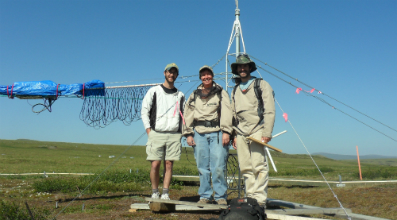CNR 4 Net Radiometer in Arctic Climate Research
Published: Wednesday, July 10, 2013
“Arctic regions are experiencing much faster responses to climate change than the lower latitudes. Scientists are trying to better understand the mechanisms that control tundra ecosystems; for example in our project we are looking at nutrient cycling and the role that Nitrogen plays in limiting plant growth and decomposition.” writes Susan Steiner in her blog on a visit to a robotic sensor platform with our CNR 4 net radiometer among the sensors on it.
The NIMS (Networked Info Mechanical System) is a trolley with a suite of sensors that moves along cables suspended between two towers for the ITEX-AON (International Tundra Experiment - Arctic Observation Network) project. The objective is to collect data on phenology, plant growth, community composition and ecosystem properties, as part of a greater effort to study environmental change in the Arctic.
The CNR 4 net radiometer measures short wavelengths of light coming in from the Sun and being reflected back from the Earth, and long wavelengths emitted by the atmosphere and the surface. It provides real-time information about amounts of energy coming and going. Together with the other sensors the NIMS collects baseline data across the Arctic in order to better understand how things are changing.
Read the full blog of Susan Steiner here.
The ecological research by Florida International University Department of Biological Sciences, in the North Slope of Alaska is also featured in our newsletter 24.

Nate Healey, Susan Steiner and Jose Luciani at the trolley site
Photos by Susan Steiner (PolarTREC 2012), Courtesy of ARCUS
See the tram powered International Tundra Experiment explained in below video interview bywww.FrontierScientists.com: